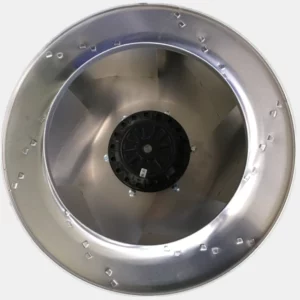A backward centrifugal fan, also known as a backward curved fan or a backward inclined fan, is a type of centrifugal fan that operates by generating airflow through the interaction of rotating impeller blades and the centrifugal force.
Here’s a simplified explanation of how a backward centrifugal fan works:
- Impeller Design: The fan consists of a rotating impeller, which is a set of curved blades arranged in a circular or spiral pattern. The blades are curved in the opposite direction of the rotation, hence the term “backward.” This design allows the impeller to draw air in from the center and direct it outward.
- Rotation: When the fan motor is turned on, it rotates the impeller at high speed. The rotation of the impeller creates a centrifugal force that pushes the air outward from the center of the impeller.
- Air Intake: As the impeller rotates, it draws air into the center of the fan through the intake or inlet. The backward-curved shape of the blades helps to guide the air inwards and prevent it from flowing back out.
- Air Acceleration and Direction: As the air is drawn in by the rotating blades, it accelerates due to the centrifugal force. The backward-curved blades impart velocity to the air, causing it to move in a tangential direction away from the impeller.
- Air Discharge: The high-velocity air is then directed towards the outlet or discharge of the fan. The curved shape of the blades gradually decelerates the air and redirects it in a more axial direction, parallel to the fan’s axis. This generates a high-pressure airflow with reduced turbulence.
- Airflow and Pressure: The generated airflow and pressure depend on various factors, including the speed of the impeller, the shape and angle of the blades, and the motor power. Backward centrifugal fans are known for their ability to deliver relatively high static pressure, making them suitable for applications that require moving air against resistance, such as ventilation systems or air handling units.
It’s important to note that the actual design and operation of backward centrifugal fans can vary depending on specific manufacturers, applications, and fan sizes. The principles described above provide a general understanding of how these fans work, backward centrifugal fan but detailed performance characteristics and design considerations can differ among different fan models and configurations.
Where is the backward centrifugal fan used?
Backward centrifugal fans find applications in various industries and systems where the movement of air or gas is required.
Some common areas where backward centrifugal fans are used include:
- HVAC Systems: Backward centrifugal fans are widely used in heating, ventilation, and air conditioning (HVAC) systems. They are employed for supply and exhaust air handling in commercial buildings, residential spaces, offices, schools, hospitals, and other facilities. These fans provide efficient air circulation, maintain indoor air quality, and help control temperature and humidity levels.
- Industrial Ventilation: Backward centrifugal fans are utilized in industrial settings for ventilation and air movement. They can be employed to exhaust fumes, dust, and contaminants from manufacturing plants, warehouses, workshops, and other production facilities. These fans are often selected for their ability to handle high static pressures and provide reliable airflow in demanding industrial environments.
- Process Cooling: Backward centrifugal fans are used in cooling systems for various industrial processes. They can be found in cooling towers, air-cooled heat exchangers, and refrigeration units. These fans help dissipate heat by drawing ambient air across heat exchange surfaces, facilitating efficient cooling in industrial processes such as power generation, chemical production, and manufacturing.
- Cleanroom Applications: Backward centrifugal fans are suitable for cleanroom environments where strict air quality and contamination control are required. They are utilized in pharmaceutical facilities, semiconductor manufacturing, research laboratories, and other cleanroom applications to maintain a clean and controlled airflow.
- Dust Collection Systems: Backward centrifugal fans are often integrated into dust collection systems or industrial air filtration systems. They are used to create suction and draw in air containing dust particles or other airborne contaminants. The high static pressure capabilities of these fans facilitate effective dust extraction and filtration.
- Commercial Kitchens: Backward centrifugal fans are utilized in commercial kitchen exhaust systems. They help remove smoke, grease, and odors from the cooking area, ensuring a safe and comfortable working environment. These fans are designed to handle the high temperatures and grease-laden air typically found in commercial kitchen exhaust systems.
- Air Purification Systems: Backward centrifugal fans are employed in air purification systems and air scrubbers. These systems are used to remove pollutants, allergens, and odors from indoor air, providing cleaner and healthier environments in residential, commercial, and industrial spaces.
- Aerospace and Automotive: Backward centrifugal fans are utilized in aerospace and automotive applications for cooling and ventilation purposes. They find use in aircraft cabin air circulation systems, engine cooling, and vehicle HVAC systems.
These are just a few examples of where backward centrifugal fans are commonly used. The specific application and fan selection depend on factors such as airflow requirements, static pressure needs, environmental conditions, and industry standards.
